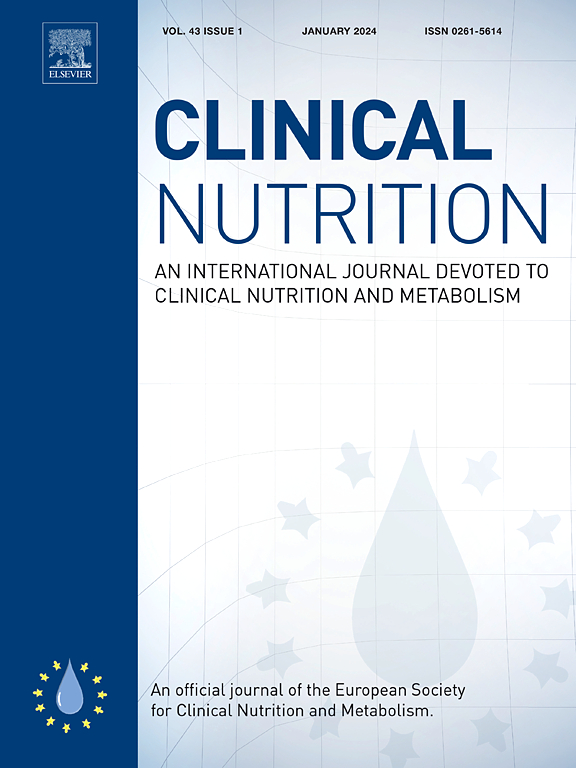口服苦味化合物后干预对餐后血糖反应的影响:随机对照试验的系统回顾和荟萃分析
IF 6.6
2区 医学
Q1 NUTRITION & DIETETICS
引用次数: 0
摘要
背景与ampamp; 目的苦味受体家族(TAS2Rs)对苦味化合物的口后感应被认为可以调节人类的餐后血糖。然而,相关报道并不一致。本系统性综述采用荟萃分析法综合了苦味化合物干预对人类餐后血糖反应的影响。方法系统地检索了从开始到 2024 年 4 月的电子数据库(Medline、PubMed 和 Web of Science),以确定报道利用口服后苦味化合物与安慰剂干预对餐后 t = 2 小时血浆葡萄糖水平(2 h-PPG)以及葡萄糖、胰岛素和 c 肽的曲线下面积(AUC)的影响的随机对照试验。通过随机效应分析和亚组分析,计算出总体加权平均差(WMD)和预定义标准的加权平均差(WMD)。慢性干预降低了 2 h-PPG(n = 21,WMD = -0.35 mmol/L,95%CIs = -0.58,-0.11),但没有降低葡萄糖或胰岛素的 AUC。亚组分析显示,前者在血糖受损、干预时间超过三个月或服用奎宁类药物的人群中尤为明显。急性干预并没有改善餐后血糖反应,但亚组分析显示,奎宁族用药后,葡萄糖的AUC有所下降(n = 4 WMD = -90.40 (nmol × time/L), 95%CIs = -132.70, -48.10)。奎宁类化合物的急性干预也可能改善餐后血糖。鉴于证据的质量很低,仍需采用更严格的方法进行进一步研究。本文章由计算机程序翻译,如有差异,请以英文原文为准。
The effect of post-oral bitter compound interventions on the postprandial glycemia response: A systematic review and meta-analysis of randomised controlled trials
Background & aims
The post-oral sensing of bitter compounds by a family of bitter taste receptors (TAS2Rs) is suggested to regulate postprandial glycemia in humans. However, reports are inconsistent. This systematic review used meta-analysis to synthesise the impact of bitter compound interventions on the postprandial glycaemic response in humans.
Methods
Electronic databases (Medline, PubMed, and Web of Science) were systematically searched from inception to April 2024 to identify randomised controlled trials reporting the effect of interventions utilising post-oral bitter compounds vs. placebo on postprandial plasma glucose levels at t = 2 h (2 h-PPG), and area under the curve (AUC) of glucose, insulin, and c-peptide. The random-effect and subgroup analysis were performed to calculate pooled weighted mean differences (WMD), overall and by predefined criteria.
Results
Forty-six studies (within 34 articles) were identified; 29 and 17 studies described chronic and acute interventions, respectively. The chronic interventions reduced 2 h-PPG (n = 21, WMD = −0.35 mmol/L, 95%CIs = −0.58, −0.11) but not AUC for glucose or insulin. Subgroup analysis showed the former was particularly evident in individuals with impaired glycemia, interventions longer than three months, or quinine family administration. The acute interventions did not improve the postprandial glycemia response, but subgroup analysis revealed a decrease in AUC-glucose after quinine family administration (n = 4 WMD = −90.40 (nmol × time/L), 95%CIs = −132.70, −48.10).
Conclusion
Chronic bitter compound interventions, particularly those from the quinine family, may have therapeutic potential in those with glycemia dysregulation. Acute intervention of the quinine family may also improve postprandial glucose. Given the very low quality of the evidence, further investigations with more rigorous methods are still required.
求助全文
通过发布文献求助,成功后即可免费获取论文全文。
去求助
来源期刊

Clinical nutrition
医学-营养学
CiteScore
14.10
自引率
6.30%
发文量
356
审稿时长
28 days
期刊介绍:
Clinical Nutrition, the official journal of ESPEN, The European Society for Clinical Nutrition and Metabolism, is an international journal providing essential scientific information on nutritional and metabolic care and the relationship between nutrition and disease both in the setting of basic science and clinical practice. Published bi-monthly, each issue combines original articles and reviews providing an invaluable reference for any specialist concerned with these fields.
 求助内容:
求助内容: 应助结果提醒方式:
应助结果提醒方式:


